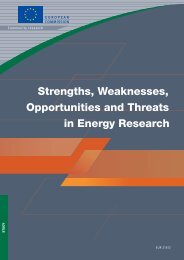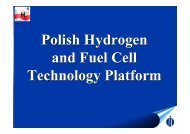Danish Strategy for Hydrogen and Fuel Cells - HY-CO Home
Danish Strategy for Hydrogen and Fuel Cells - HY-CO Home
Danish Strategy for Hydrogen and Fuel Cells - HY-CO Home
You also want an ePaper? Increase the reach of your titles
YUMPU automatically turns print PDFs into web optimized ePapers that Google loves.
metal (or other) hydrides is much more expensive than other kinds of storage<br />
based on today’s technology, <strong>and</strong> commercial application is still a long way away.<br />
Use of hydrogen<br />
<strong>Hydrogen</strong> is a flammable gas similar to natural gas <strong>and</strong> can be used in the same<br />
way, e.g. <strong>for</strong> normal combustion in a boiler or <strong>for</strong> the production of CHP in<br />
engines <strong>and</strong> turbines or the propulsion of vehicles using st<strong>and</strong>ard spark-ignition<br />
motors.<br />
The challenge is to identify areas <strong>and</strong> applications in which the use of<br />
hydrogen is of benefit to the environment while at the same time ensuring a<br />
more reliable energy supply. In this regard, fuel cell technology is one of the<br />
most promising future technologies due to its high energy-conversion<br />
efficiency.<br />
<strong>Fuel</strong> cell technology<br />
A fuel cell converts hydrogen to electricity <strong>and</strong> heating <strong>and</strong> the only waste<br />
product of this process is steam. In addition, the fuel utilisation ratio, especially<br />
<strong>for</strong> electricity production, is relatively high (Table 3). A fuel cell can also<br />
reverse the process, i.e. convert electricity to hydrogen <strong>and</strong> oxygen. Over the<br />
last 20 years, there has been increasing interest in fuel cells all over the world,<br />
<strong>and</strong> considerable amounts are today being invested in fuel cell systems <strong>for</strong> both<br />
CHP plants <strong>and</strong> vehicle transportation with a view to developing commercially<br />
viable solutions.<br />
There are many different types of fuel cells,<br />
but the <strong>Danish</strong> fuel cell strategy is based on<br />
PEM (Proton Exchange Membrane) <strong>and</strong><br />
SOFC (Solid Oxide <strong>Fuel</strong> Cell).<br />
These two types of fuel cells can probably<br />
be used in other areas than heat <strong>and</strong> power<br />
production.<br />
<strong>Danish</strong> R&D in this field is<br />
primarily undertaken by Risø<br />
National Laboratory, Haldor<br />
Topsøe, IRD <strong>Fuel</strong> <strong>Cells</strong>, DTU <strong>and</strong><br />
APC Denmark. The University of<br />
Southern Denmark <strong>and</strong> Aalborg<br />
University also contribute. In<br />
addition, many <strong>Danish</strong> companies<br />
have also shown considerable<br />
interest in fuel cells <strong>and</strong> their use in<br />
energy <strong>and</strong> transport systems.<br />
As far the transport sector is concerned<br />
(cars, buses), the PEM cell is expected to be<br />
the preferred fuel cell. In addition, PEM fuel cells are expected to become<br />
popular in various niche markets, e.g. <strong>for</strong> the propulsion of <strong>for</strong>klift trucks,<br />
h<strong>and</strong>icap vehicles, as UPS (Uninterruptible Power Supply) back-ups,<br />
emergency power supplies <strong>and</strong> h<strong>and</strong>-held electronic equipment (replacing<br />
batteries in laptops <strong>and</strong> mobile phones).<br />
The table below shows the timeframe <strong>for</strong> the development of a market <strong>for</strong> fuel<br />
cells in Europe until the year 2020.<br />
14




